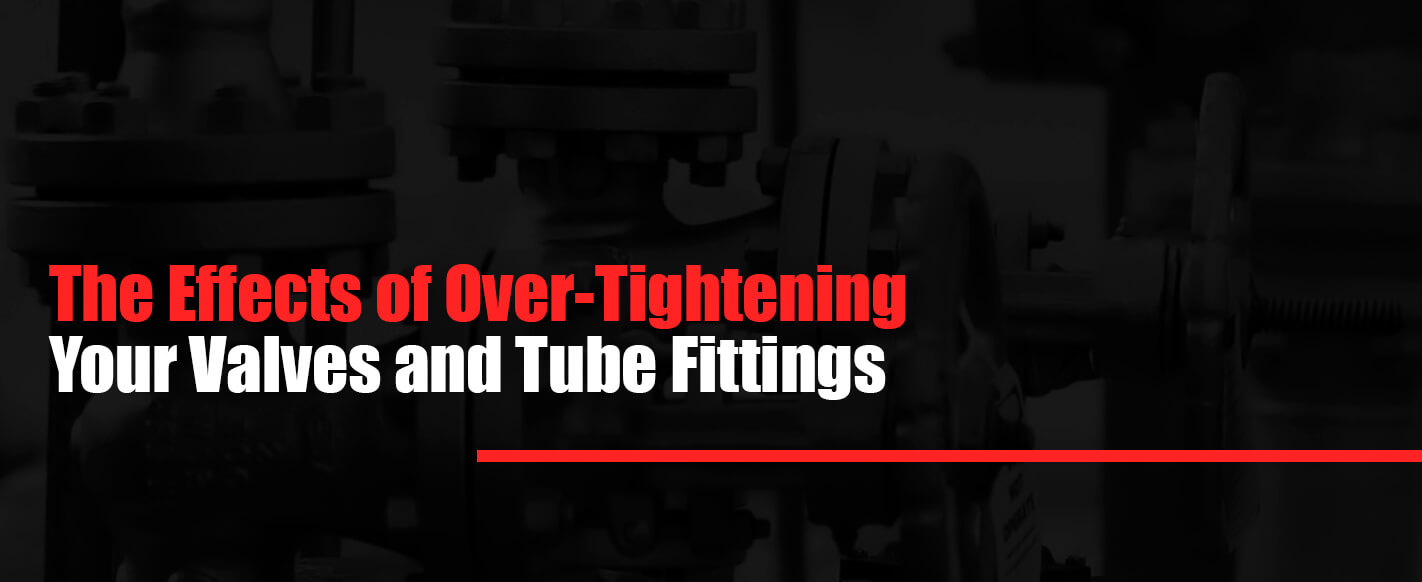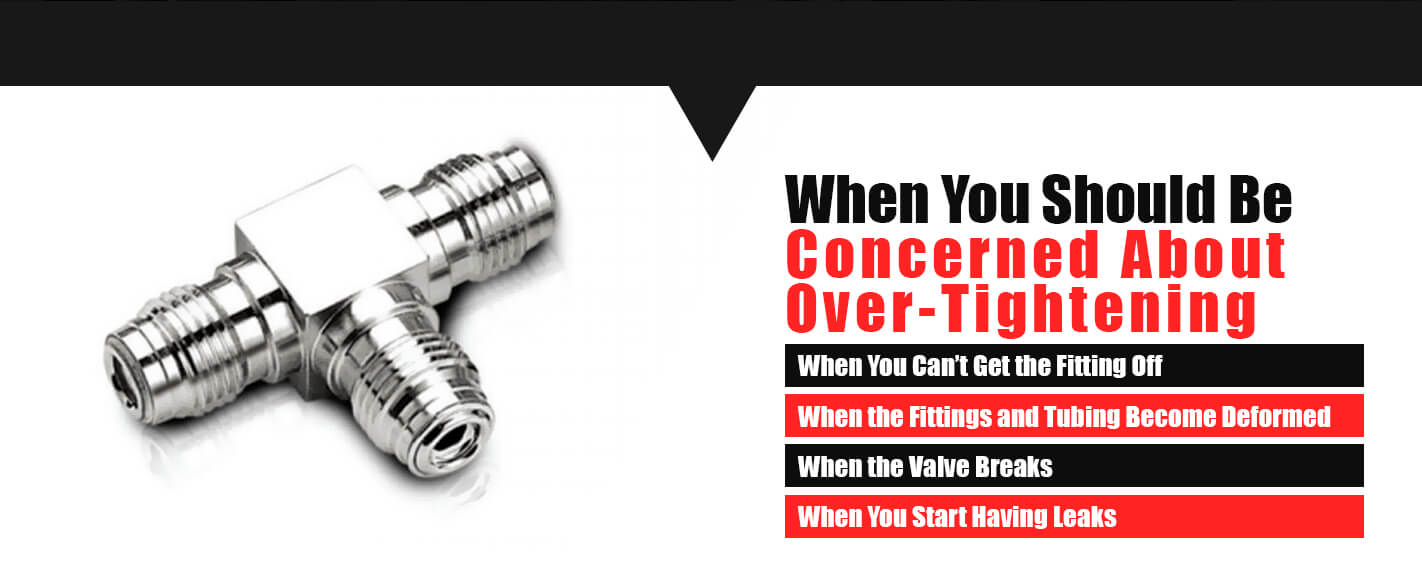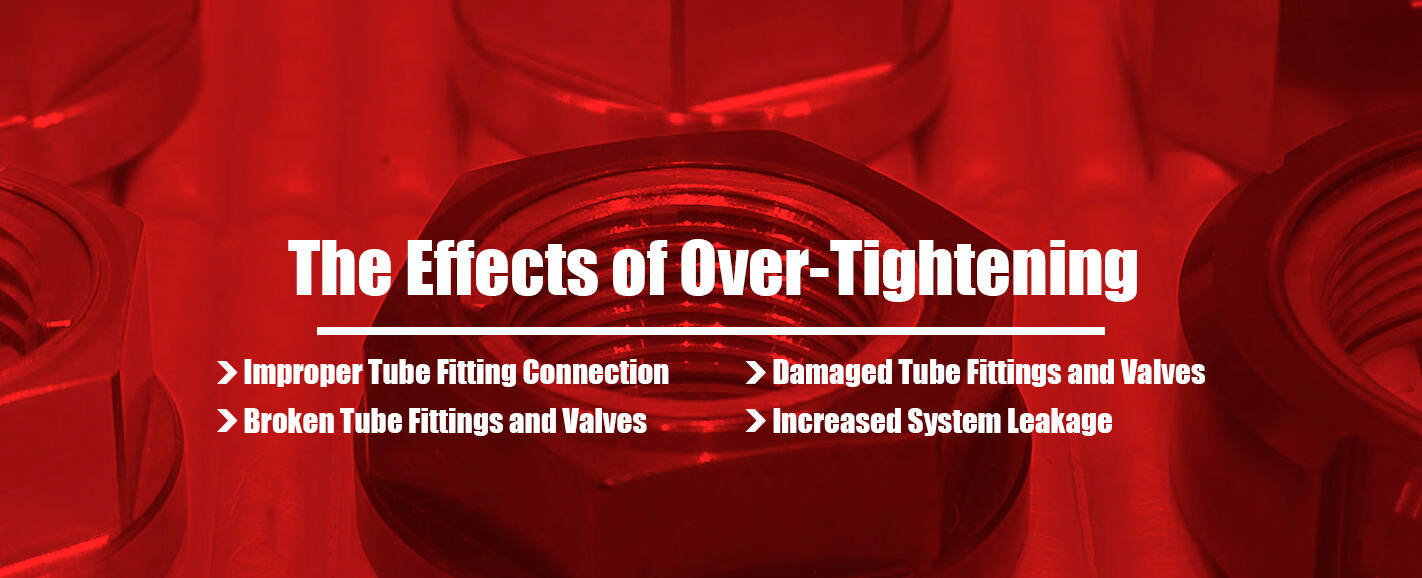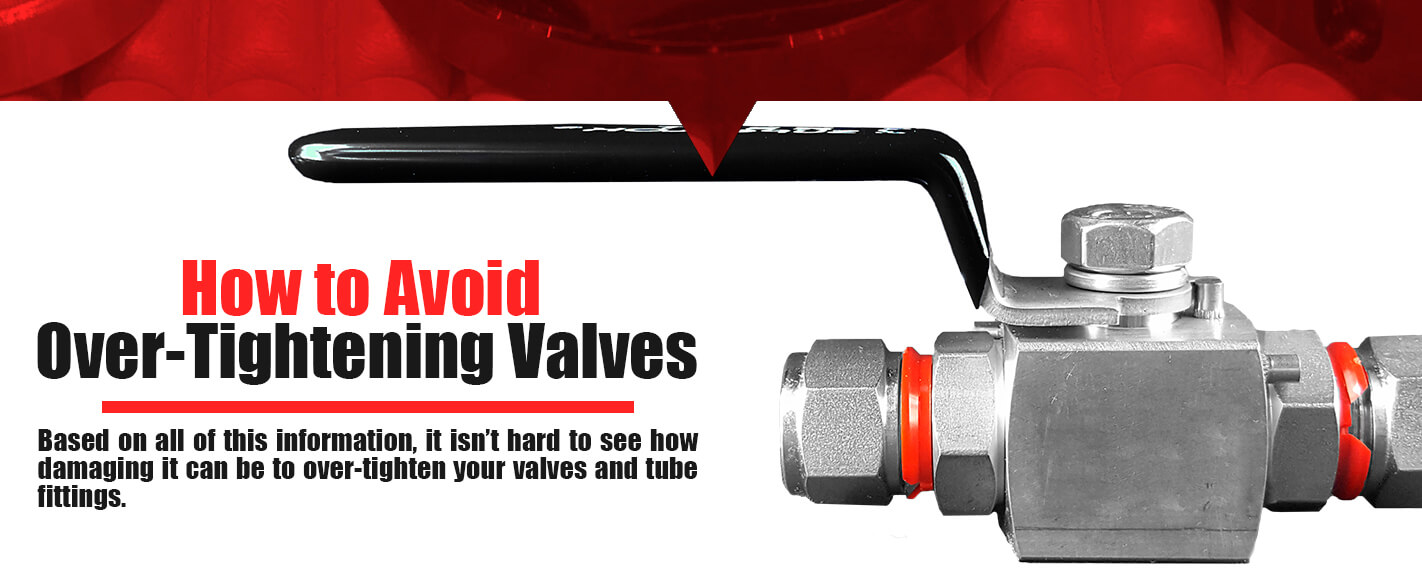 When the topic of tube valves and tube fittings arises, one of your first thoughts may be about the importance of proper tightening. Whether the tubing in question are a simple part of a factory-wide network or part of a hydraulic system, it’s crucial that all the joints and fittings are sealed together tightly, with no room for any fluids to leak out between the cracks.
When the topic of tube valves and tube fittings arises, one of your first thoughts may be about the importance of proper tightening. Whether the tubing in question are a simple part of a factory-wide network or part of a hydraulic system, it’s crucial that all the joints and fittings are sealed together tightly, with no room for any fluids to leak out between the cracks.
However, too much of a good thing can always turn into a bad thing, and this holds as true for tube fittings as it does for anything else. Over-tightening a valve or tube fitting can lead to a whole host of problems, just as under-tightening these same joints would also be a problem on the opposite side of the spectrum.
To help you navigate this potential pitfall, we’ve compiled this brief overview of the problem. Because both over- and under-tightening can lead to unfortunate consequences, we’ll discuss how to stay in the middle of that range and tighten your fittings just the right amount.
When You Should Be Concerned About Over-Tightening
 Tightening your valves and tube fittings is an important part of installing and maintaining your equipment. After all, failure to apply tightening of any kind would lead to disastrous consequences, as fluid would leak out rapidly. In other words, tightening a valve is a good thing.
Tightening your valves and tube fittings is an important part of installing and maintaining your equipment. After all, failure to apply tightening of any kind would lead to disastrous consequences, as fluid would leak out rapidly. In other words, tightening a valve is a good thing.
When does it become a problem, however? When should you start to be concerned that perhaps you’re leaning too far towards over-tightening a valve? Here are four ways you can tell:
1. When You Can’t Get the Fitting Off
Have you ever tightened a valve or fitting to the point where it was so tight you couldn’t get it off again? This is a good indicator that perhaps you’ve taken things too far. The fitting could even be tightened to the point of damaging the connecting tubes.
2. When the Fittings and Tubing Become Deformed
Imagine you’re tightening a fitting — turning it with your hand, a wrench or using a gap gauge — and the fitting is growing tighter and tighter. As it gets tighter, however, you start to notice that the fitting itself is deforming slightly. Maybe one side is bulging out or caving in. Alternatively, perhaps the tubing itself that’s connected to the fitting is being forced into a new shape or is collapsing at the end.
These are all signs that the fitting is either an incorrect fit and simply doesn’t match the tubing, or that it’s been tightened too far. If the valve is turned too many times and forced tighter than it should be, this additional pressure is added to the tubing, warping its shape and leading to further types of damage down the road.
3. When the Valve Breaks
If you’re tightening a valve or tube fitting and it actually breaks off in your hand, you can feel certain you tightened it too far. This isn’t a very common scenario, as most valves are quite sturdy and will not break. If this does happen to you, exercise caution the next time you tighten a valve and be sure you don’t apply quite as much pressure.
4. When You Start Having Leaks
This is a slightly trickier possibility because leaks could arise from many other sources. In fact, leaks could even be the result of a valve that hasn’t been tightened enough. Nevertheless, if you find yourself experiencing fluid leaks, it’s time to check your various tubing connections and see if they’ve been tightened too tightly.
If a valve is over-tightened, it deforms the tubing and the connection, as mentioned earlier. These deformities create cracks and gaps where the fluid can begin leaking out.
The Effects of Over-Tightening
 If you have a tendency towards over-tightening, the next logical question is, “So what?” Why does it matter if you over-tighten your fittings? What’s the worst that can happen and why should it matter to you?
If you have a tendency towards over-tightening, the next logical question is, “So what?” Why does it matter if you over-tighten your fittings? What’s the worst that can happen and why should it matter to you?
As it turns out, there are plenty of very good reasons why you should care. This habit of over-tightening will have a direct impact on your projects and operations. With this in mind, here are a few of the biggest effects of over-tightening your valves.
1. Improper Tube Fitting Connection
An over-tightened valve means the connection between the tubes is neither as precise nor secure as it should be. Imagine that you have two tubes and the valve represents the joint between the two, allowing fluids to flow from one tube into the next. If the valve has been over-tightened, this connection will be warped.
This could lead to a whole host of problems. For example, depending on just how deformed the connection has become, it could lead to fluids being blocked, leaving them to clog up the tubes. If there’s anything solid passing through the tubes, this possibility increases. Additionally, the potential for leakage skyrockets. These deformities create gaps in the tubes, creating little tiny spaces for fluid to leak out and drip down the tubes and onto the floor, leading to more problems.
Additionally, improper connections due to over-tightening could lead to contamination. This is because of those same gaps that would allow for leaks. If there’s enough room for fluid to come spilling out of these cracks, there’s also enough room for dirt, chemicals, and other foreign liquids to enter your plumbing or tubing system and contaminate it. This can lead to the faster breakdown of your tubes, costing you more money as you’re forced to replace them due to this unforeseen contamination.
2. Damaged Tube Fittings and Valves
Over-tightening your valves or tube fittings is, quite simply, not good for them. It stretches and warps them beyond the limits of their intended tolerances. Once they’ve been stretched in this way, they’re unlikely to ever regain their initial shape, making them impossible to reuse in any other context.
They’re also more likely to continue stretching and warping with time, meaning that even if they’re technically doing their job and they maintain the connection between your tubes now, they’re unlikely to continue doing this job for long. This means you’ll have to go back out shopping to purchase new valves.
It isn’t just the valves themselves that will be damaged, however. Most likely, the tubes themselves will also be compromised. Before too long, they will need to be replaced as well. Because high-quality tubes and tube fittings do not come cheaply, this is some expensive equipment that you’re causing irreparable damage to, simply from over-tightening.
3. Broken Tube Fittings and Valves
In addition to simply deforming and damaging your tube fittings, over-tightening these crucial pieces of equipment actually has the potential to break them altogether. Imagine the enormous pain and trouble that could result if these fittings give way while liquid is flowing through the tubes.
Broken fittings and valves will unquestionably lead to additional costs: to replace the parts themselves and then to repair anything that has been damaged during the process. If other parts of the adjoining tubes have been broken or damaged, these will need to be replaced as well. And anything that was damaged by the resulting spill will also need repairs.
4. Increased System Leakage
We mentioned this earlier as a potential side effect of several of the other problems we’ve talked about. But it’s such a potentially disastrous problem that it deserves its own category as well. When your tube fittings are over-tightened, causing them to deform and allowing for leakage, here are just a few of the negative side effects you may experience:
- Safety Concerns: If there is liquid leaking out of your tubes, there’s a good chance someone might slip and hurt themselves. An avoidable injury is unfortunate enough, but if this accident occurs in a workplace, it could lead to additional complications such as paid injury leave or lawsuits.
- Environmental Concerns: All that extra fluid leaking out of the tubes doesn’t just disappear. It eventually finds its way into local water systems, polluting them and wreaking havoc on the local ecosystem. This hurts plants, animals and, eventually, even people themselves.
- Equipment and Area Damage: Leaking wears away at the interior along the edges of the leak, widening it and making it more serious as time goes on. Additionally, whatever’s in the path of the leakage, such as the floor, the wall, or another tube, may also suffer damage from the leaks.
- Higher Costs: Everything that’s been damaged because of the leak will eventually need to be replaced, leading to higher costs. Additionally, any plumbing, tubing, or machinery system that these tubes are a part of will need to work harder, using more fuel and driving up your energy bills, water bills or any other relevant expenses.
5. Aggravated Natural Wear Process
All tube fittings, valves, and tubing will wear out over time. No matter how well you care for them and perform regular maintenance, no equipment will last forever. Your tube fittings are no different. What you do have control over is how fast they wear out.
If you regularly check them for leaks or damage, clean them, and make sure everything is working as intended, then you increase the likelihood that they’ll live long and fully productive lives. If, on the other hand, you crank the fittings to well beyond their maximum intended levels of tightness, you increase the rate at which these pieces of equipment will wear out. This over-tightening puts the entire system under enormous strain and pressure, causing it to break down much faster than it ordinarily would.
As these parts wear down, they’ll cease to do their job. If they don’t break entirely, they’ll no longer be able to create an effective seal between the tubes, leading to leakage, warping, and other types of expensive damage. Ultimately, you’ll be forced to replace the tubes far sooner than you would have otherwise.
How to Avoid Over-Tightening Valves
 Based on all of this information, it isn’t hard to see how damaging it can be to over-tighten your valves and tube fittings. We know that it can lead to all kinds of damage and end up costing you a hefty price. We’ve even talked about some warning signs that might be trying to alert you to the fact that you might be over-tightening.
Based on all of this information, it isn’t hard to see how damaging it can be to over-tighten your valves and tube fittings. We know that it can lead to all kinds of damage and end up costing you a hefty price. We’ve even talked about some warning signs that might be trying to alert you to the fact that you might be over-tightening.
But what happens if you learn you have been over-tightening? How do you fix this problem and guarantee it won’t happen again? There are a couple of things you can do:
1. Use Caution
This one’s simple, and it just involves paying attention as you tighten your valves. Notice when the valve begins to feel tight and be aware of how much tightening you do after you’ve already reached this point. While it isn’t always easy to play the situation entirely “by ear,” it’s still a good idea to simply pay attention to what you’re doing and watch for signs that the valve is protesting as you attempt to tighten it further.
2. Don’t Fight It
As you’re tightening your valve, if you’re beginning to feel resistance and like the valve is tightened to capacity, don’t push it. Don’t continue cranking it to the point where it’s painful to turn. Certainly, you want to tighten it to the point where it isn’t falling off, but you don’t want to keep going too far past the point of resistance.
3. Use Better Technology
Here at Mako Products, we believe there should be a simpler and more straightforward way to tell if your pipe fitting is tightened correctly. With Superlok technology, that’s exactly what you’ll get. The Superlok I-Fitting come with a built-in gap gauge. This means that as you tighten the fitting the proper amount, a red ring will physically pop off of the fitting, revealing a blue ring underneath and giving you visual confirmation that your fitting has been tightened optimally.
This eliminates the need to wonder whether you’ve tightened it far enough and removes the temptation to give it a few more turns “just to be safe” that all too often results in over-tightening. With Superlok technology, you don’t have to worry — you can know for sure.
Visit Mako Products Today for More Information
 Have you struggled in the past with over-tightening your fittings? Do you often worry that you haven’t tightened them enough, so you veer too far in the opposite direction and deform your valves through over-tightening?
Have you struggled in the past with over-tightening your fittings? Do you often worry that you haven’t tightened them enough, so you veer too far in the opposite direction and deform your valves through over-tightening?
Learn more about how we can help you solve these problems with the practical and no-nonsense solutions we offer here at Mako Products, your number-one source for Superlok products. Learn more about Superlok’s I-Fitting technology and how it can make your life easier and eliminate over-tightening problems. And once you’ve learned how this technology can solve your tightening issues, don’t hesitate to contact us to learn more about how you can integrate these fittings into your own system.
